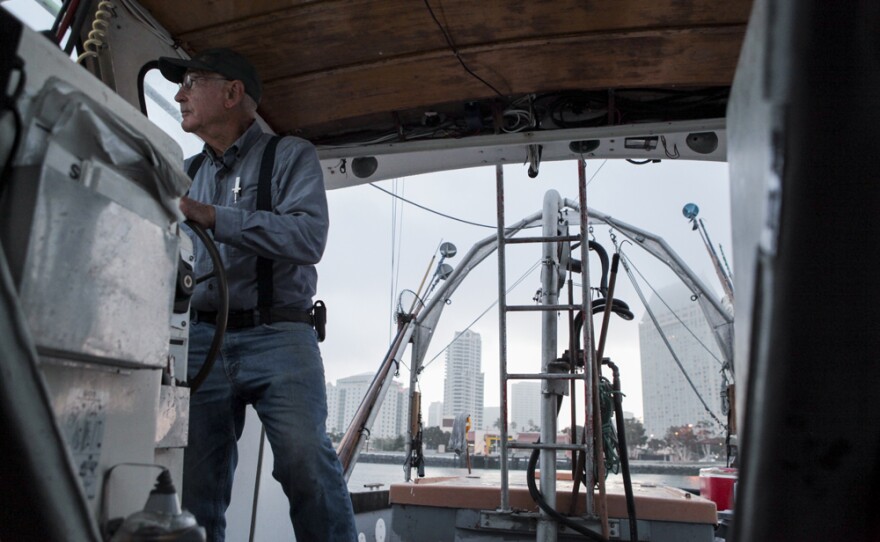Commercial fishermen who expected that a proposed redevelopment of the San Diego waterfront would include land set aside solely for their industry found out Thursday that the Port of San Diego may have other ideas.
The flare-up over the future of the waterfront came as the port proposed new zoning designations as part of its Port Master Plan Update process.
Along Tuna Harbor, the land that San Diego’s commercial fishermen hoped would stay classified as “commercial fishing” is being proposed as “mixed use,” allowing for flexibility in development instead of being dedicated to the infrastructure and expansion of the commercial fishing industry.
To be fair, most of the waterside land and piers in the Central and North Embarcadero planning districts — which runs from the Manchester Grand Hyatt hotel in the south to the San Diego International Airport in the north — is also being labeled as mixed use. Driscoll’s Wharf, another commercial fishing marina one mile north, is designated in the new plan as purely commercial fishing.
Peter Halmay, along with several other fishermen, expressed frustration to port commissioners during a daylong public workshop.
“That idea of changing commercial fishing on G Street Mole to mixed use seems a little scary at this time,” Halmay said. “We know what commercial fishing is, we don’t know what mixed use is.”
Maritime attorney Peter Flournoy told the board of port commissioners that with respect to the fishermen in the room, “I think you need to give them something definite they can count on.”
For close to a year, San Diego’s commercial fishermen have been meeting with Yehudi Gaffen, the developer behind the proposed $1.2 billion Seaport project along the Central Embarcadero. Together, they have been working out plans to revitalize an industry that once defined this city. With new infrastructure and significant changes to the land surrounding Tuna Harbor, the two sides hoped to kickstart that process. Their meetings have at times been tense, but together they have found common ground and a hesitant truce.
The port’s recent rollout of the new zoning proposal came as a shock to both Gaffen and the fishermen — though they had very different reactions.
Gaffen told inewsource the fishermen believe he had a hand in the port’s proposed designations. He denied any involvement, but said he is happy to see the new plans allow for flexibility because it will help him implement his vision “in the short term.” If not, he added, his development could get “painted into a corner.”
“There has to be a certain amount of trust here,” Gaffen said about the fishermen’s concerns.
Lesley Nishihira, a port senior planner for land use, told inewsource Wednesday that mixed use “doesn’t mean any and all type of development.”
“It doesn’t mean that the underlying use designations go away. All we’re doing is saying that within a mixed use overlay area, it allows for flexibility in the arrangement of specific use categories that will be specified by policy language.”
The overlays will be clarified later, Nishihira said, with specific policies related to each area.
At one point in Thursday’s meeting, Commissioner Bob Nelson was critical of the mixed use designations, calling them “a poster child for abuse.”
“If we know what we want a thing to be, let’s say what we want it to be,” Nelson said.

In a way, using vague overlays that allow for mixing up roads, parks and other structures safeguards the port from what happened to its North Embarcadero Visionary Plan in the early 2000s. That plan had very specific land use designations and structures, and when those plans (which became law in 2001) weren’t implemented, it drew a series of lawsuits, public uproar and a legacy of distrust.
Port commissioners appeared receptive to the fishermen’s concerns, asking questions of staff about Coastal Act protections, existing land use designations and the ability to change plans. In the end, they directed port staff to come up with a draft of specific policy language for the land around Tuna Harbor.
Halmay left the board with his take on mixed use:
“When you buy a bag of mixed nuts, you have no idea what’s in there,” he said.
“It’s generally 90 percent peanuts — but they don’t want to tell you that.”
The next public workshop is May 11 at 6 p.m. at the National City Aquatic Center.








